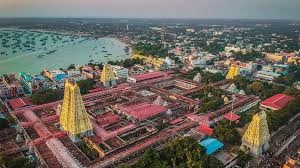




Rameswaram is a unique blend of religious significance, cultural history, and natural beauty. Including more about its aspects would cover:
Ramayana Connection: Rameswaram is deeply rooted in the Hindu epic, the Ramayana. According to the story, it is from here that Lord Rama, with the help of Hanuman and his Vanara (monkey) army, built a floating stone bridge, known as "Rama Setu" or "Adam's Bridge," to reach Lanka (present-day Sri Lanka) and rescue Sita from the demon king Ravana. The remnants of this bridge are believed to still exist beneath the shallow waters between India and Sri Lanka.
Ritual Bathing: Devotees visiting the Ramanathaswamy Temple perform ritual bathing in the 22 sacred wells or "Theerthams." The waters of these wells are believed to possess unique healing properties, and taking a dip is considered to purify the soul.
Ramanathaswamy Temple: One of the 12 Jyotirlinga temples dedicated to Lord Shiva, it is an architectural marvel. The temple is famous for its longest corridor among all Hindu temples, adorned with intricately carved pillars and large Gopurams (temple towers). The temple's construction, spanning centuries, was completed during the 12th century by the Pandya kings.
Agni Theertham: This is one of the most important of the 64 sacred baths in India, located at the seashore, just in front of the Ramanathaswamy Temple. Pilgrims take a holy dip here before entering the temple.
Pamban Island and Bridge: Rameswaram is located on Pamban Island, connected to mainland India via the Pamban Bridge. The bridge, a vital link, is India’s first sea bridge and stands as an engineering marvel. The adjacent rail bridge is still in operation, providing scenic views for passengers traveling by train.
Dhanushkodi: The town at the southern tip of Rameswaram Island, now in ruins after being destroyed by a cyclone in 1964, is of both historical and religious significance. It is also known for the "Rama Setu Point," marking the beginning of the mythical bridge to Lanka. The town's pristine beaches and calm waters draw many visitors.
Part of Char Dham: Rameswaram is one of the four important pilgrimage sites in the Char Dham Yatra, which also includes Badrinath, Puri, and Dwarka. These sites are spread across the four corners of India and represent the spiritual journey for Hindus.
Vaishnavism and Shaivism Confluence: Rameswaram stands as a sacred place for both Shaivites (followers of Lord Shiva) and Vaishnavites (followers of Lord Vishnu). The religious inclusiveness is marked by the fact that the rituals performed here honor both Rama and Shiva.
Kothandaramaswamy Temple: Situated near Dhanushkodi, this ancient temple is dedicated to Lord Rama and is believed to be the site where Rama performed the "Pattabhishekam" (coronation) of Vibhishana, the brother of Ravana, as the king of Lanka.
Villondi Theertham: It is another sacred beach known for its calm waters, and it is believed that Lord Rama dipped his arrow in the sea to create fresh water here for Sita to quench her thirst after crossing the bridge from Lanka.
Including these aspects, Rameswaram is not only a religious destination but also a place rich in history, mythology, culture, and natural beauty.